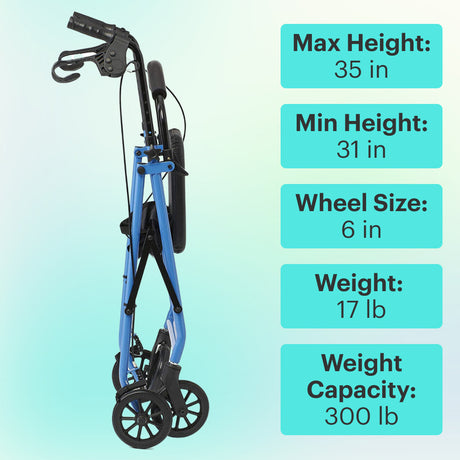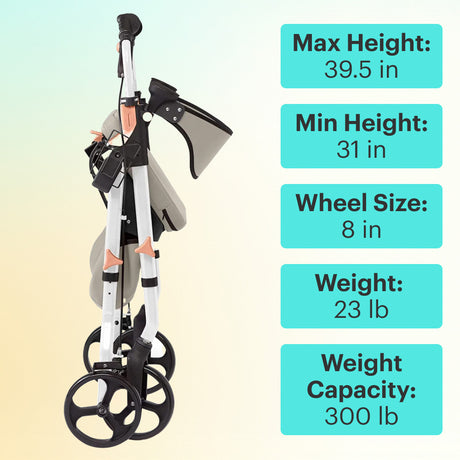Rollators can help seniors and other people with mobility issues lead more active lives. They can make a big difference for those hoping to age in place and remain in their own homes for as long as possible. To get the most out of these mobility aids, you need to know how to operate and maintain the key components.
The braking system on a rollator is one of the most important parts. Being able to operate the brakes correctly and adjust them as needed can help you use your rollator more safely and easily. In this guide, we’ll introduce the types of brakes found on rollators, explain how to lock them, and provide instructions for making rollator brake adjustments. By the end, you’ll have an overall better understanding of rollator brakes and be ready to operate them wherever you go.
How to Adjust Walker Brakes
Most rollators have a brake adjuster that allows you to make the brakes more or less sensitive. Continue reading to find out why this feature is helpful and how to make a rollator brake adjustment as needed.
Brake sensitivity has a big impact on ease of use. If the brakes are too sensitive, your rollator may lurch to a stop too sharply, potentially setting you off balance. On the other hand, brakes that aren’t responsive enough could make your rollator difficult to control and pose safety risks.
Identifying the Adjustment Mechanism
Often, the brake adjuster on a rollator is a small nut located where the brake cable meets the brake. Locate the mechanism on your rollator, consulting the owner’s manual as needed.
Rollators have different types of brakes. Although variations exist, there are generally three main types of rollator brakes: loop lock, bicycle-style, and push-down. Let’s take a look at each type of brake, one by one.
Loop Lock Brakes
Loop lock brakes are easy to identify because they have large plastic loops positioned under the hand grips. These loops are parallel to the handles and easy to quickly access. When you want to slow down your rollator, you squeeze both loops. When you want to activate the locking mechanisms, you usually push the loops downward. To continue walking, you then pull them back into their original position.
Bicycle-Style Hand Brakes
As their name suggests, bicycle-style hand brakes draw inspiration from bicycle brakes. The brake controls are levers positioned below the handles. To slow down, you simply squeeze the brake levers. Locking mechanisms on this type of brake vary. In some cases you may push the levers down. Other designs require you to move a pin or press a button to lock.
Push-Down Brakes
Push-down brakes are an alternative to bicycle-style and loop lock brakes. They can be a good option for individuals with declining mobility who have difficulty squeezing due to a weak grip, arthritis pain, or another health condition. These brakes are built into the handlebars, so you only need to push down on the grips to slow down movement. By applying even more pressure, you can then lock the brakes.
The downside to this type of brake is that it can take some time to get used to it. Some users may find themselves accidentally engaging the brakes or locking their rollators when they don’t intend to.
Adjusting the Brake Tension
To adjust the brakes, you typically tighten the nut to increase sensitivity and loosen it to reduce it. However, you should refer to the specific instructions included with your rollator to find out which way to turn the nut.
Testing the Adjusted Brakes
After making adjustments, try employing the brakes to see how they perform. Readjust as needed until the braking system is ideally set for your needs.
How to Tighten the Brakes on a Rollator
Tightening the brakes on a rollator is a straightforward process that ensures safety and stability during use. Firstly, locate the brake adjustment knob or screw typically positioned near the handle grips. Next, using the appropriate tool, usually an Allen wrench or screwdriver, rotate the knob or screw clockwise to tighten the brakes. Test the brakes by gently squeezing them to ensure they engage properly and hold securely. If necessary, make further adjustments until the desired level of tightness is achieved.
Signs Your Walker Brakes Need Adjustment
Recognizing signs that your walker brakes require adjustment is crucial for maintaining safety and functionality. Firstly, if you notice the walker rolling unexpectedly or not stopping promptly when the brakes are engaged, it's a clear indication that adjustments are needed. Similarly, if the brakes feel loose or too tight, causing difficulty in operation, it's time for adjustment. Another sign is if the walker drifts to one side when stationary, suggesting uneven brake tension. Additionally, any unusual noises or grinding sensations when applying the brakes may indicate wear or misalignment.

The Importance of Proper Walker Brake Adjustment
When you compare a rollator vs. a walker, the wheeled models are often easier to operate. With a rollator, you don’t have to lift your mobility device as you walk. Instead, you can continuously take small steps as your rollator rolls along with you, just like a wheelchair does when someone pushes it. Overall, rollators can be easier to use for those with no previous experience walking with a traditional walker or cane.
For all their benefits, the wheels on a walker can lead to some safety concerns. When moving downhill, a rollator might start to move too quickly, posing a risk that it could slip out of grasp. Plus, navigating tight spaces or making a sharp left or right turn can be tricky in some cases.
To address these issues, manufacturers usually add brakes to the handles of walkers. By employing the brakes, you can slow down your walker to maintain control. Many rollators take things one step further with locking brakes. By locking the brakes, you can completely stop your walker from rolling. This feature increases stability when you want to stand in one place or take a break and sit on a rollator’s built-in seat.

How to Lock Walker Brakes Safely
The correct way to lock the brakes on your rollator walker will depend on its design. Be sure to check the instructions included with your mobility aid for specific directions. Although there will be differences from model to model, the following steps are usually involved when you lock the brakes on a rollator.
Step 1: Positioning the Rollator Walker
Before locking the brakes, get the rollator walker into the proper position. If you’re planning to sit or stand for a while, move off to the side out of the path of foot traffic. Line your walker up how you want it, straightening the front and rear wheels out as much as possible.
Step 2: Locating the Brake Handles
Once you have your rollator in position, find the brake handles. As explained above, they may be loops, levers, or built into the handles of your rollator.
Step 3: Locking the Brakes
Upon locating the brake handles, employ the locking mechanism by doing one of the following:
- Loop brakes: Push the loops down as far as they will go.
- Bicycle-style brakes: Push the brakes down, slide the pin in place, or press the lock button.
- Push down brakes: Push down on the handlebars until you feel the locking mechanism engage.
Step 4: Verifying the Brakes Are Securely Locked
Before you lean your weight onto the rollator while standing or sitting down on the seat, double-check your work and be sure that the brake lock mechanism is activated. To do so, just try to push the front wheels of the rollator forward. If the rollator easily rolls, the brakes likely aren’t locked. In this instance, try again by repeating the process from Step 1.

Tips for Locking Walker Brakes Safely
To ensure safety, follow these tips when locking and operating rollator brakes.
Always Lock the Brakes When Sitting or Standing
If you plan to remain stationary while standing or want to sit on the seat of your rollator, be sure to lock the brakes. Otherwise, the rollator may slip out from underneath you when you apply your weight.
Use the Brakes When Turning
The brakes on a rollator work independently from one another. Each one has its own cable that connects to the hand brakes positioned below the grips or integrated into the handlebars. This design can help you make tight turns with your rollator.
When you need to turn, apply the brakes on the side that you’re turning toward. This will slow down the wheels on one side while allowing the other to move freely, making it possible for you to turn. Here’s a quick reference for how to make right and left turns and slow down your rollator:
- To make a right turn: Engage the brakes on the right side only.
- To make a left turn: Engage the brakes on the left side only.
- To slow down while going straight: Engage both brakes at the same time.
Maintain Proper Posture When Using a Rollator Walker
Maintaining proper posture while walking with your rollator can improve stability and reduce stress on your muscles, bones, and joints. Here are the components of proper posture:
- Head: Keep your head lifted and your eyes focused ahead of you.
- Neck: Lengthen your neck as much as possible.
- Shoulders: Roll your shoulders back and keep them square as you walk.
- Arms: Your arms should have a slight bend of about 15 degrees.
- Back: Strive to make your spine as long and straight as possible.
- Core: Engage your abdominal muscles slightly for better support.
- Legs and feet: Point your toes and the fronts of your legs straight ahead, and step from heel to toe.
If you find it difficult to maintain proper posture, or your arms are too bent or too straight, you may need to adjust the height of your walker.

Troubleshooting Common Walker Brake Adjustment Issues
Troubleshooting common walker brake adjustment issues is essential for maintaining the safety and functionality of the walker. Addressing these issues promptly ensures that the brakes operate effectively, providing stability and confidence for users during mobility assistance.
Unresponsive Brakes
To troubleshoot unresponsive brakes on a walker, first, check if the brake cables are properly connected and not damaged. Next, ensure that the brake pads are not worn out and are making adequate contact with the wheels. If the issue persists, try adjusting the brake tension using the adjustment knobs or screws provided, and if necessary, consult the manufacturer's manual for further guidance.
Uneven Brakes
To troubleshoot uneven brakes on a walker, start by inspecting the brake pads on each side to ensure they are wearing evenly and making consistent contact with the wheels. Next, check the brake cables and adjust them to ensure equal tension on both sides. If the issue persists, consider replacing any worn brake components and realigning the brakes to ensure uniform performance.
Brakes That Lock in Place
To troubleshoot brakes that lock in place on a walker, first, check for any debris or obstructions that might be causing the brakes to jam. Next, inspect the brake cables and adjust them to ensure they are not overly tight, which can cause the brakes to lock prematurely. If the issue persists, consider lubricating the brake mechanism.
Looking for a new rollator walker? Check out the rollators available at Because Market.














